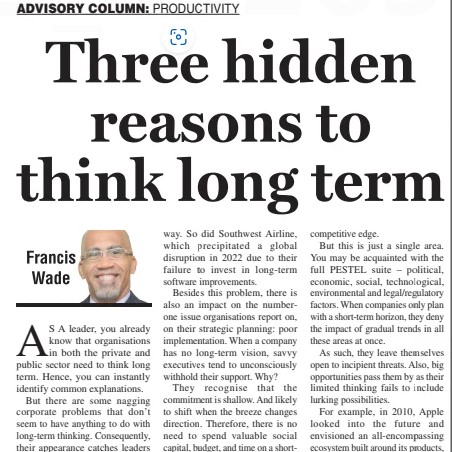You are a leader, and are well aware that both private and public sector organizations must prioritize long-term thinking. As a result, you can immediately enumerate some of the main reasons.
However, there are persistent corporate issues that appear unrelated to long-term planning. Therefore, their sudden presence catches leaders off-guard. Failing to complete a long-term strategic plan can lead to three anticipated but uncommon issues.
1. Commitments at Cross-Purposes
Consider an organization that has invested substantial time and effort into crafting a meticulous three-year strategic plan. The document lays out clear goals, milestones, and performance indicators to work towards over that relatively short timeframe. However, when gazing further into the future, a lack of cohesion emerges among the executive team and board members. Each leader has their own personal vision for where the company should be in four, ten, or thirty years. But there is no consensus or shared strategic roadmap beyond the three-year horizon.
This divergence in perspectives can undermine decision-making processes. Without alignment on long-term direction, executives rely on their own criteria when charting the future course. The cumulative impact of this disjointed approach to leadership can be highly detrimental. It leads to missed opportunities, strategic missteps, and organizational stagnation or decline. Unified commitment to a long-term vision enables more focused decision-making and progress.
In addition to this problem, there is also a detrimental effect on the top issue that organizations often report in their strategic planning – the lackluster execution. In the absence of a long-term vision, perceptive executives often find themselves involuntarily holding back their support. Why?
They can tell that the commitment is superficial. And likely to shift in a moment. Hence, it is unnecessary to invest precious social capital, budget, and time into a fleeting plan that may have a 50% likelihood of being discarded.
- Missing Important Trends
I recently revisited Competing for the Future by Hamel and Prahalad, immersing myself once again in their groundbreaking insights. In this 1994 classic, they accurately foresaw the influence of emerging technologies.
It was quite interesting to note that they were mostly correct in their observations. Taking their predictions seriously would have allowed a company to establish a distinct competitive edge.
However, this is only one small section of the larger landscape. You may be familiar with the comprehensive PESTEL suite, which encompasses Political, Economic, Social, Technological, Environmental, and Legal/Regulatory factors. By only planning with a short-term horizon, companies fail to acknowledge the cumulative effects of gradual trends in all these areas simultaneously.
By doing so, they make themselves vulnerable to potential dangers. Additionally, they miss out on significant opportunities because they fail to consider the hidden possibilities.
For example, Apple had a visionary glimpse into the future, imagining a comprehensive ecosystem that revolved around their products, services, and the cloud. Most likely, they were in possession of the identical information as everyone else. What set it apart?
Around 2010, they devised a comprehensive plan that spanned a decade, gradually constructing a complete solution, piece by piece. From their near-collapse in 1997, they have risen to become one of the most valuable companies in the world today. In the face of an existential threat, they boldly seized an opportunity that came their way.
- Not Doing Succession Planning
Most organizations find it challenging to create succession plans. Why? Letting incumbents go unchallenged and accepting their perpetual rule is the easier option.
It’s only when you consider the long-term consequences that you realize the folly of this approach.
For example, it becomes evident that the necessary skills to navigate the company through upcoming transitions are lacking. A person nearing retirement may not be the most suitable candidate for tackling a new learning curve.
But that’s just scratching the surface. As soon as talented middle managers sense the lack of long-term direction, the sights of them browsing job listings and attending networking events become more frequent.
Over time, companies find themselves staffed by an ineffective majority, trapped in a state of stagnation. However, the situation takes a turn for the worse. Eventually, as the “last men standing”, members of this cohort receive promotions, even to the highest executive positions.
To prevent these three slow-moving disasters, your team must engage in strategic planning that integrates short and long-term perspectives.

